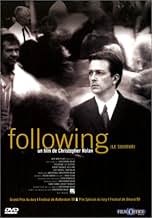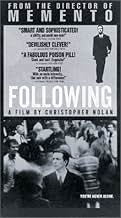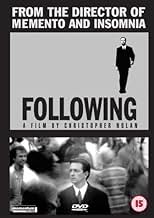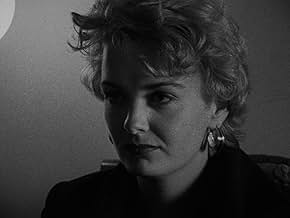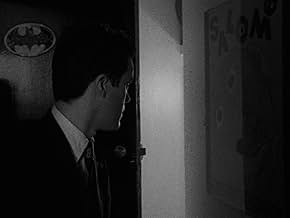Um jovem escritor que segue estranhos em busca de material encontra um ladrão que o coloca sob sua proteção.Um jovem escritor que segue estranhos em busca de material encontra um ladrão que o coloca sob sua proteção.Um jovem escritor que segue estranhos em busca de material encontra um ladrão que o coloca sob sua proteção.
- Prêmios
- 5 vitórias e 4 indicações no total
Avaliações em destaque
Great film. No gratuitous gimmicks like in most Hollywood films. Everything supported the suspense of the plot. B&w gave it a basic, no-frills feel also. In short, it was visceral in its simplicity of cinematography and cast.
Following serves as an interesting contrast to Memento. Characters in both used manipulation and subterfuge extensively. In that sense, both reminded me somewhat of "In the Company of Men," also highly recommendable. One difference between Nolan's two films is that Memento was a little easier for me to follow, given that the b&w scenes progress in a constant chronological direction, and so do those in color. I don't think that was true of Following, where scenes seemed to be shown at random. If you have the choice between VCR and DVD, I'd highly recommend DVD, since that gives you the option of watching the movie a second time in chronological order, not just in the scrambled (albeit ingenuous) order presented by Nolan. It also makes it easier, upon a second viewing, to piece the order together for yourself, if you want to.
As another viewer noted, one of the best things about both this movie and Memento is that none of the cast were famous. They were characters, not big-name actors who brought in personas developed in other movies.
Given certain similarities in the plots, I wonder if Memento is sort of a remake of Following, but intended to reach a bigger audience, like Edward Burns made She's the One in the mold of -- and with largely the same cast as -- The Brothers McMullan.
Following serves as an interesting contrast to Memento. Characters in both used manipulation and subterfuge extensively. In that sense, both reminded me somewhat of "In the Company of Men," also highly recommendable. One difference between Nolan's two films is that Memento was a little easier for me to follow, given that the b&w scenes progress in a constant chronological direction, and so do those in color. I don't think that was true of Following, where scenes seemed to be shown at random. If you have the choice between VCR and DVD, I'd highly recommend DVD, since that gives you the option of watching the movie a second time in chronological order, not just in the scrambled (albeit ingenuous) order presented by Nolan. It also makes it easier, upon a second viewing, to piece the order together for yourself, if you want to.
As another viewer noted, one of the best things about both this movie and Memento is that none of the cast were famous. They were characters, not big-name actors who brought in personas developed in other movies.
Given certain similarities in the plots, I wonder if Memento is sort of a remake of Following, but intended to reach a bigger audience, like Edward Burns made She's the One in the mold of -- and with largely the same cast as -- The Brothers McMullan.
In this intriguing noir thriller (looking like the Forties, but with a psychology befitting the Nineties), Director Christopher Nolan employs a number of techniques he would perfect in his internationally acclaimed Memento (2000), most notably scenes presented out of time sequence for effect, and a naive protagonist taken advantage of by others. The film opens with "Bill, the Innocent" (as I might dub him), played by Jeremy Theobald, trying to explain to someone, perhaps a social worker, perhaps even a police inspector (John Nolan), why he took up following people just for the fun of it. He doesn't just follow women, he points out. He's not a stalker, as such. He's just curious. He's an intriguing and sympathetic character, a Brit writer with a lot of time on his hands who seems something of a throwback to an earlier age with his clanking manual typewriter and the photo of a pursed-lips Marilyn Monroe on the wall of his shabby apartment. Things began to go wrong for him, he further explains, when he broke some of his "following rules" and got too close to his prey. What he doesn't know and what we don't know yet, is that his clumsy following technique has allowed him to unwittingly become the followed himself. Enter a juicy blonde (Lucy Russell) walking down some steps from her apartment. (This scene is out of sequence as far as chronological time goes, but psychologically speaking, her appearance signals his entanglement). Enter now a scheming, sophisticated psychopathic thrill-seeker named Cobb (Alex Haw) who entices Bill with his (apparent) practice of burglary just for the powerful feeling one gets from invading the sanctity of another's life. Although justification for the temporal inversions here is not as clearly established as in Memento, nonetheless the technique works well, and Nolan provides us with a clever ending that sneaks up on us and makes in a few seconds all that went before clear. Or mostly clear. You might want to rewind and view the first few minutes of the film, and then everything should be clarity. This low-budget, black and white, deliciously ironic little film (71 minutes) marked the auspicious debut of a film maker who has already made quite a name for himself, not only with the aforementioned Memento, but with Insomnia (2002). It will be interesting to see what Nolan does next.
I just finished watching Following and I thought it was great. I rated it 8 out of 10. I plan on watching it again with the director's commentary and then again in chronological order.
I rented this movie because of my fascination of Christopher Nolan's more recent movie Memento. Following has some similarities; this movie was probably the blueprint for Memento. Even the music in some parts is very similar.
Shooting the movie in black and white gives it a mysterious feel. The story and dialogue is really good. The performance of the actors is believable.
Christopher Nolan made this movie on a really low budget. I look forward to his next release Insomnia, a big budget movie with my favourite actor Al Pacino.
I rented this movie because of my fascination of Christopher Nolan's more recent movie Memento. Following has some similarities; this movie was probably the blueprint for Memento. Even the music in some parts is very similar.
Shooting the movie in black and white gives it a mysterious feel. The story and dialogue is really good. The performance of the actors is believable.
Christopher Nolan made this movie on a really low budget. I look forward to his next release Insomnia, a big budget movie with my favourite actor Al Pacino.
Saucy, eh ? If at all you're familiar with Christopher Nolan's style of film-making, watching this will at once make you realize where it all started. Its also of course possible that it began much before this but since much of that material isn't accessible to the public (save Doodlebug), we'll never really know. For all purposes, Following remains Nolan's feature film debut and it surely is a remarkable achievement.
The story follows Bill, a struggling unemployed writer who takes a liking to following people in hopes of finding material to write about. This liking soon turns into addiction forcing Bill to set rules to allow him to restrain his activities. One of the rules which he ends up breaking, is following the same person twice. The person with whom this rule is broken is Cobb, who soon confronts Bill about being followed. As it turns out, Cobb is a burglar who enjoys robbing people, not for the money, but rather for the sheer pleasure in taking away things that people took for granted; his belief being that it would make them realize what they had. Taken away by Cobb's lifestyle, Bill becomes a partner in his burglaries which is where the trouble begins.
Digging any more into the plot would serve to spoil the complex mystery that Following is. Following has a lot of those narrative structures that would become trademarks of Nolan's directorial style (intercuts, close-up inserts, non-linear editing, multiple chronologies, and so on). Nolan and crew were forced to make certain hard choices to obscure the severely limited budget, one of which was shooting the film in black and white. Of course, the plot was such that these decisions worked the film's favor. The film's incredible naturalism repeatedly comes to mind while watching the film. This is due largely in part to the film being shot hand-held, with scenes filmed in a take or two to save on film stock. The behind the scenes material with the film reveals this and other fascinating details about the film's production such as the crew shooting over weekends due to their jobs on weekdays as a result of which the film took a year to complete.
Despite the low budget, you're always hooked on to Following and that is due largely in part to the film's plot and tight writing (another of Nolan's strengths). Unlike many filmmakers who use lavish editing styles and gimmicky display effects, Nolan's films rely primarily on story and screenplay to get the viewers attention (with the occasional non-linear editing thrown in to really keep the audience alert at all times). Add to it, the intriguing characters which have personalities so distinct it appears Nolan himself followed a handful of people to get the traits right. Jeremy Theobald is as natural as the gullible Bill as Alex Haw is suave in the role of Cobb. And the chemistry between the two is so natural, it makes most of the dialogues they say seem improvised, as though real people were conversing.
Following is a great start for Nolan who has now moved on to bigger, elaborate and definitely better projects. It is a lesson for aspiring filmmakers that even with a limited budget, it is possible to make a feature as interesting, riveting and thrilling as some of the best noirs of the early 40s. While it may not be perfect, most of the limitations it suffers from are largely due to production values rather than plotting and pacing. It is nevertheless, a must watch for anyone who has even the slightest of respect for Christopher Nolan's film-making.
Overall Score: 7.0 / 10
The story follows Bill, a struggling unemployed writer who takes a liking to following people in hopes of finding material to write about. This liking soon turns into addiction forcing Bill to set rules to allow him to restrain his activities. One of the rules which he ends up breaking, is following the same person twice. The person with whom this rule is broken is Cobb, who soon confronts Bill about being followed. As it turns out, Cobb is a burglar who enjoys robbing people, not for the money, but rather for the sheer pleasure in taking away things that people took for granted; his belief being that it would make them realize what they had. Taken away by Cobb's lifestyle, Bill becomes a partner in his burglaries which is where the trouble begins.
Digging any more into the plot would serve to spoil the complex mystery that Following is. Following has a lot of those narrative structures that would become trademarks of Nolan's directorial style (intercuts, close-up inserts, non-linear editing, multiple chronologies, and so on). Nolan and crew were forced to make certain hard choices to obscure the severely limited budget, one of which was shooting the film in black and white. Of course, the plot was such that these decisions worked the film's favor. The film's incredible naturalism repeatedly comes to mind while watching the film. This is due largely in part to the film being shot hand-held, with scenes filmed in a take or two to save on film stock. The behind the scenes material with the film reveals this and other fascinating details about the film's production such as the crew shooting over weekends due to their jobs on weekdays as a result of which the film took a year to complete.
Despite the low budget, you're always hooked on to Following and that is due largely in part to the film's plot and tight writing (another of Nolan's strengths). Unlike many filmmakers who use lavish editing styles and gimmicky display effects, Nolan's films rely primarily on story and screenplay to get the viewers attention (with the occasional non-linear editing thrown in to really keep the audience alert at all times). Add to it, the intriguing characters which have personalities so distinct it appears Nolan himself followed a handful of people to get the traits right. Jeremy Theobald is as natural as the gullible Bill as Alex Haw is suave in the role of Cobb. And the chemistry between the two is so natural, it makes most of the dialogues they say seem improvised, as though real people were conversing.
Following is a great start for Nolan who has now moved on to bigger, elaborate and definitely better projects. It is a lesson for aspiring filmmakers that even with a limited budget, it is possible to make a feature as interesting, riveting and thrilling as some of the best noirs of the early 40s. While it may not be perfect, most of the limitations it suffers from are largely due to production values rather than plotting and pacing. It is nevertheless, a must watch for anyone who has even the slightest of respect for Christopher Nolan's film-making.
Overall Score: 7.0 / 10
Christopher Nolan's first feature film wowed critics who saw it when it first came out. Shot on a micro budget of $6,000 this is a student film with real class. The film is shot in black and white, and features people who you assume are friends of Nolan's appearing in the movie. This is not to say they are bad actors because they are quite good. You could see Jeremy Theobald and Alex Haw appearing in other projects but unfortunately they haven't since this was made 6 years ago.
Nolan's thriller, much like Memento, does not play chronologically, it shifts the scenes around much like Pulp Fiction. The writing is fantastic. It is a great twisting thriller but because the temporal order of the film is shifted around it makes it even more interesting. I thought the last ten minutes in particular when everything starts to become clear were excellent.
For a film of such a small budget and with no recognizable names at all, this is so good. It is superior to most that Hollywood studios offer and Nolan after three films (this, the superior Memento and the not quite as good but still excellent Insomnia) has cemented himself as the most exciting new talent of recent times. I can't wait for Batman.
This film is short and sweet and certainly a great watch. It is very professional and the twists are fantastic and completely surprising. I also thought that the score from David Julyan was also excellent, very atmospheric and had a chilly quality to it. He has gone on to compose Nolan's other films.
Overall I would recommend this, I intend to get all of Nolan's films. This is a low budget gem. *****
Nolan's thriller, much like Memento, does not play chronologically, it shifts the scenes around much like Pulp Fiction. The writing is fantastic. It is a great twisting thriller but because the temporal order of the film is shifted around it makes it even more interesting. I thought the last ten minutes in particular when everything starts to become clear were excellent.
For a film of such a small budget and with no recognizable names at all, this is so good. It is superior to most that Hollywood studios offer and Nolan after three films (this, the superior Memento and the not quite as good but still excellent Insomnia) has cemented himself as the most exciting new talent of recent times. I can't wait for Batman.
This film is short and sweet and certainly a great watch. It is very professional and the twists are fantastic and completely surprising. I also thought that the score from David Julyan was also excellent, very atmospheric and had a chilly quality to it. He has gone on to compose Nolan's other films.
Overall I would recommend this, I intend to get all of Nolan's films. This is a low budget gem. *****
Você sabia?
- CuriosidadesSir Christopher Nolan never studied film-making at university. He studied English Literature at University College London, and used the film society there to shoot the opening dialogue scene between Bill and the policeman.
- Erros de gravaçãoDuring the safe robbery, Bill is clearly shown wearing gloves, most noticeably when he pulls the paper with the combination from his pocket. However, as he starts to open the safe, the gloves are gone and they never reappear.
- Cenas durante ou pós-créditosThe movie was filmed from 1996 to 1997 and first released in 1998. However, the copyright date in the credits is listed as being 1999.
- Versões alternativasThe Criterion Collection DVD features an additional "Chronological Edit" of the film, which places the scenes in linear order.
- ConexõesFeatured in Smashing UK Top 10: Top 10 Film Directors (2013)
Principais escolhas
Faça login para avaliar e ver a lista de recomendações personalizadas
- How long is Following?Fornecido pela Alexa
Detalhes
Bilheteria
- Orçamento
- US$ 6.000 (estimativa)
- Faturamento bruto nos EUA e Canadá
- US$ 48.482
- Faturamento bruto mundial
- US$ 126.052
- Tempo de duração1 hora 9 minutos
- Cor
- Mixagem de som
- Proporção
- 1.37 : 1
Contribua para esta página
Sugerir uma alteração ou adicionar conteúdo ausente



